Click this messge to hide it.
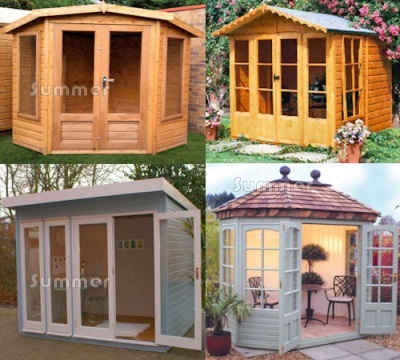
- We deliver a huge range of summerhouses and garden rooms throughout the UK.
- We also offer installation and base laying with selected summerhouses in many areas.
- We offer 3-7 day delivery with some wooden summerhouses.
- All prices include delivery and VAT.
Please click on the headings below to see information about the options available:
Use our Search Options to find your ideal summerhouse fast
We offer a huge choice of hundreds of summerhouses, some of which are available in many sizes with a choice of features. Overall there are thousands of variations. With so much choice, it can be a challenge to find the best summerhouse for your needs. Our Search Options are designed to help.
FIND YOUR SUMMERHOUSE FAST
Whenever you browse our Summerhouses category, the Search Options panel can always be found at the top of the page. Even if you click on a summerhouse to view the details, you can recall the Search Options panel at any time if you click on the Summerhouses button at the top of the page.
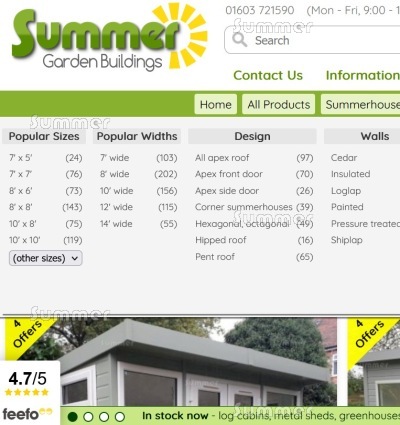
PICTURE: The Search Options panel at the top of the page.
- Click on our Search Options to narrow your search.
- Scroll down to see information about each Search Option, including Popular Sizes, Design, Walls, Glazing, Doors, Roof and More Options.
- Try more than one search to be sure you find the best summerhouse for your needs.
- For most searches you only need to select one or two filters.
- Scroll down to see additional information about Installation Options and Base Options.
- To see local prices and availability we need to know your area. Click here to enter the FIRST HALF of your POSTCODE.
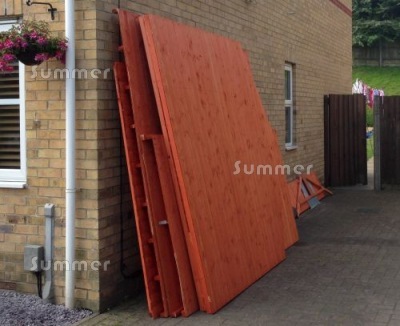
PICTURE: A traditionally made building with large prefabricated panels.
When you search for a summerhouse there are a number of other words which could describe the building you are searching for. Somebody else looking for the same building could search for a shed, a log cabin, a garden room or a garden office. It may help if you search more than one of our categories.
Differences between a summerhouse and a log cabin or shed
- Different people describe their building using different words. A summerhouse to one person is a log cabin or a shed to another.
- You could miss just the right building for you if you search for one word only.
- We recommend searching every relevant category to be sure that you see the full choice.
- Traditional sheds and summerhouses are made in a fundamentally different way to a log cabin.
- A traditional shed or summerhouse features large prefabricated panels, with cladding boards fixed into framing or studwork.
- A log cabin features thicker wall logs than a shed or summerhouse, with no framing and no prefabricated wall panels.
- Most log cabins feature logs which are notched out at each end to form a distinctive criss-cross corner joint.
- A summerhouse is normally designed for seating and looking out on the garden, with large glazed doors and large windows.
- A shed is normally designed for storage with small windows and little or no glass in the door.
- A small summerhouse or shed often includes just four wall panels - the front, the rear and two sides. Larger walls may be divided into two panels.
These classifications are subjective and some of our best buildings do not fit neatly into any one category:
- Traditional summerhouses and sheds feature prefabricated panels up to 10' wide (3m) but many modern buildings feature smaller panels around 3'-6' wide (0.9m-1.8m).
- Some of our best sheds include glazed doors similar to a summerhouse and decorative glazing, with a more attractive appearance to suit a prominent location in the garden.
- Some modern log cabins feature corner posts instead of conventional corner joints but the logs are otherwise the same.
- Some of our smaller hexagonal, octagonal and corner log cabins feature prefabricated roof panels.
- A few of our apex and pent roof log cabins include prefabricated floor and roof panels.
- We classified a few of our log cabins as sheds because the door and window designs look more like a shed.
Differences between a summerhouse and a garden room or garden office
Garden offices and garden rooms are a modern development of traditional summerhouses. The most fundamental difference is that a traditional summerhouse is generally used only in the warmer months whereas a garden office or garden room can be used all year round. Some of the features of a summerhouse are described below:
- A summerhouse is normally single glazed with no insulation and no internal lining.
- From inside a summerhouse the internal view of the walls is similar to most wooden sheds, with boarding and framing.
- A summerhouse is typically used as a seating area for use in the summer, somewhere to sit when the weather is not quite good enough to sit outside. It can be somewhere to sit on a warm day with a bit of a breeze or a few spots of rain. A summerhouse can also be a shady retreat on a hot day or a sheltered retreat at the end of a day in the garden as the temperature outside cools.
- Because a summerhouse is often used for seating, it normally features a larger glazing area than a garden shed and often includes glazed or part glazed doors. The large glazing area allows the sun to pour in and it provides a panoramic view out over the garden.
- Double doors are a popular choice to ensure easy access between the summerhouse and the garden.
- A summerhouse may be used for a variety of diverse uses, including the storage of garden furniture, tools, mowers and other equipment.
- When used for storage, a summerhouse is often chosen in preference to a shed if it is in a prominent position where it will be more noticeable than a shed from inside your home.
- Some of our Reverse Apex Sheds feature similar designs and glazing to our Summerhouses, so it may worth looking at these before deciding.
- In recent years we have seen a growing demand for high quality garden sheds with quality doors, windows and other attractive design features but with a smaller glazing area more suited to storing unattractive items in a prominent and visible position within the garden. These designs may also be of interest for some of our summerhouse customers.
- Years ago, before garden offices were widely available, some customers would line and insulate a traditional shed or summerhouse themselves and this practice still continues occasionally today. There are some specialist situations where it is advisable, for example if you want to sound proof a shed using sound proof insulation (which is slightly different) you can use thicker insulation and not bother with the lining boards. However, we could also quote for your needs which would be much easier. Also, garden offices and garden rooms are specifically designed to include insulation which helps to ensure greater comfort and a more attractive appearance.
Some of the features of a garden room or garden office are described below:
- A garden room or garden office is normally double glazed and internally lined with floor insulation, roof insulation and wall insulation.
- From inside an internally lined garden office, the framing and external boarding are not visible.
- The internal lining boards which are often used in a garden room or garden office are also used inside the house as wall cladding, roof linings and ceilings, as an alternative to a plaster finish.
- A garden room or garden office normally includes higher specifications than a traditional summerhouse.
- The doors and windows in a garden room or a garden office are often more akin to the doors and windows in a house than a summerhouse.
- In the beginning, a few decades ago, the first garden offices were almost exclusively used as offices. At the time they were often described as home offices. Companies often purchased these expensive buildings for their employees and this practice continues to this day. During the Covid-19 pandemic the demand for garden offices increased.
- Over the years, the use of garden offices has diversified and now these high performance buildings are increasingly used in a variety of ways. Popular uses of the garden rooms we have supplied include an art studio, a beauty parlour, a nursery, a creche, a home gym, a workshop, a reading room, a study, a man cave, a teenager's bedroom and a guest bedroom. We have even supplied garden rooms which are used as bed and breakfast accommodation. This wide range of alternative uses has led to the description as a garden room, because today these buildings are an extra room, located in the garden but similar to other rooms in the house and with as many possible uses, if not more.
- Although often still used as offices in which people regularly work at home on a part time or full time basis, the term garden office is no longer such an accurate description of these buildings.
For information about other topics click here to see our Summerhouse FAQs.
Click here to see Popular Sizes
POPULAR SIZES and POPULAR WIDTHS
- We offer a huge range of sizes.
- You can use our Search Options to select a Popular Size or a Popular Width.
- If you want a specific size or width, search for the next smallest and the next largest size - your ideal summerhouse may be only an inch outside your search parameters.
- Remember to search for sizes and widths both ways. For example, search for 10'x8' and 8'x10'.
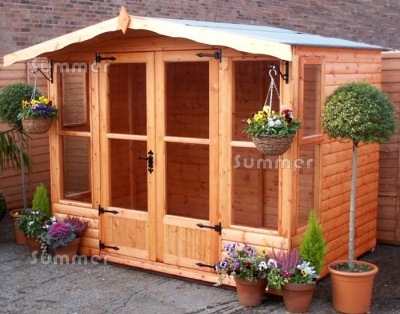
PICTURE: An 8'x6' (2.4m x 1.8m) summerhouse.
A popular small summerhouse is 7'x5' (2.1x1.5m) with enough space for 2 comfy chairs and a small table. Other popular sizes are 8'x6' (2.4x1.8m) and 7'x7' (2.1x2.1m) with room for a larger table and 4 chairs. A popular large summerhouse is 10'x8' (3x2.4m) with enough room for a dining table and up to 6 or 8 seats. Arranging furniture in your house or in a small room can often be a useful guide to the size you need. Most people buy the biggest size that fits comfortably within the available space in the garden.
Click here to see Design Options
DESIGN
You can use our Search Options to browse a wide range of designs. A summerhouse is often a prominent focal point in the garden. In a highly visible position an attractive design is important and with a commanding view of the garden a large glazing area is a popular choice.
Apex Roof Summerhouses
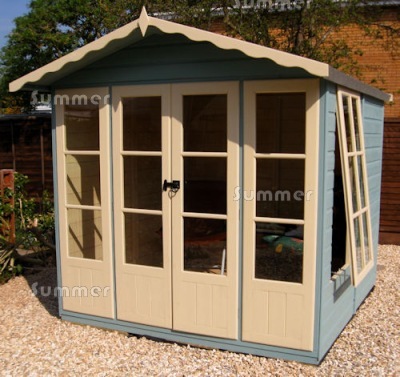
PICTURE: An apex roof summerhouse.
The apex roof design features two sloping sides which meet in the middle. The roof slopes down from the highest point (the ridge) to the lowest point (the eaves). The apex roof design combines a strong angular design with a steep roof pitch to discharge rainwater quickly and easily. The apex design also provides generous headroom inside.
Pent Roof Summerhouses
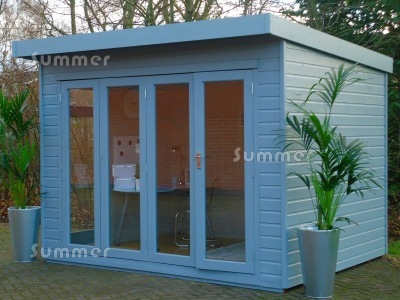
PICTURE: A pent roof summerhouse.
Pent roof summerhouses are increasingly popular. The sleek modern design is compact with a lower and less obtrusive profile than other designs. The monopitch roof is on one plane, which normally slopes down from the front to the rear. The roof is normally hidden from most angles so decorative roof coverings are often not required.
Corner Summerhouses
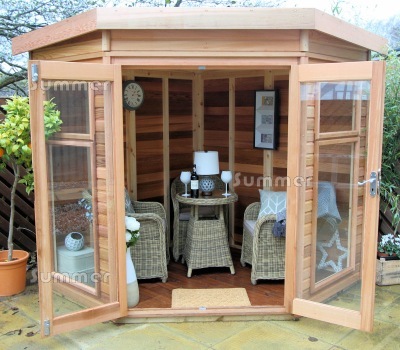
PICTURE: A corner summerhouse with a low pitch roof.
With five side walls, our corner summerhouses fit neatly in a corner. The compact modern design of a low pitch corner summerhouse provides an unobtrusive profile. There are two popular lower pitch roof designs, which are both similar in appearance. A single sloping roof slopes down from the door to the rear in a similar way to a pent roof. A double sloping roof is more like a shallow apex roof, with two roof sections each sloping down from the highest point, the ridge, which runs from the middle of the door to the rear corner.
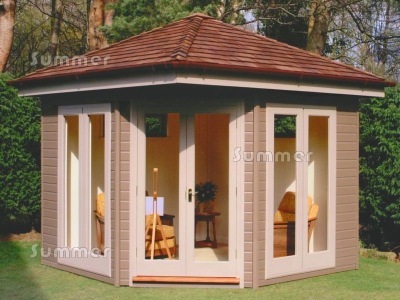
PICTURE: A corner summerhouse with a high pitch roof.
The high pitched corner summerhouse design features a pyramid shaped hipped roof with four sides sloping up to meet in the middle. The hipped roof slopes down from the highest point (the ridge) to the lowest point (the eaves). The four hips run from eaves to ridge along the joins between the roof sections. High pitch corner summerhouses are generally a little more expensive than buildings with a lower pitch, because the roof is more elaborate. The high pitch roof can be a striking design feature.
View Corner Summerhouses
Hexagonal and Octagonal Summerhouses
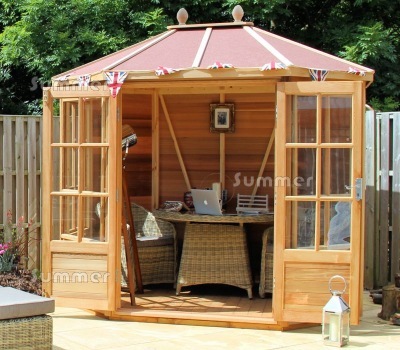
PICTURE: An octagonal summerhouse with eight side walls.
Hexagonal summerhouses feature six side walls and octagonal summerhouses feature eight side walls. The hipped roof design features six or eight sloping sides which meet in the middle of the roof. The hipped roof slopes down from the highest point (the ridge) to the lowest point (the eaves). Although elaborate, hexagonal and octagonal designs are also functional, combining a strong angular design with a steep roof pitch to discharge rainwater quickly and providing generous headroom inside.
View Hexagonal and Octagonal Summerhouses
Hipped Roof Summerhouses
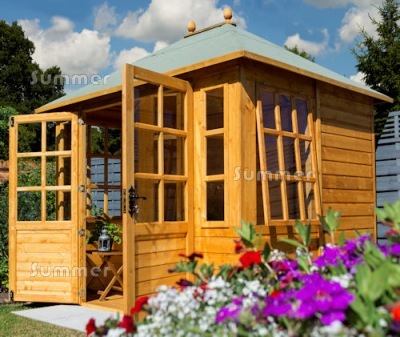
PICTURE: A hipped roof summerhouse.
The hipped roof design is pyramid shaped with four sloping sides which meet in the middle of the roof. The hipped roof slopes down from the highest point (the ridge) to the lowest point (the eaves). The hip is the architectural term for the join between each side of the roof. The hipped roof is also a striking design feature. In addition to the attractive appearance, the efficient design provides maximum use of space while the hipped roof combines a strong angular design with a steep roof pitch to discharge rainwater quickly and providing generous headroom inside.
Click here to see Wall Options
WALL OPTIONS
Use our Search Options to choose from a selection of Wall Options.
Cedar
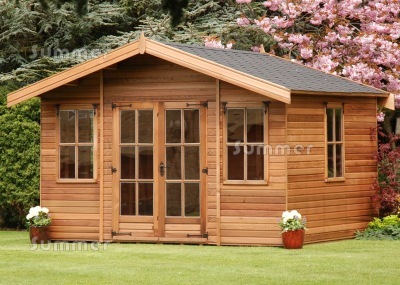
PICTURE: A cedar summerhouse.
Many of our best summerhouses feature cedar. We use Western Red Cedar, a naturally resilient timber which lasts longer than pine and other softwoods, even if never treated from new. It has deservedly earned an unrivalled reputation for its attractive appearance and extraordinary durability. It is the ideal choice for people who are too busy to maintain their summerhouse. This oily timber has a strong but pleasant aroma which repels insects. Cedar contains hardly any knots. If untreated it will fade to a silvery grey colour. Western Red Cedar is a sustainable resource from the well managed forests of North America.
View Cedar Summerhouses
Pressure Treated Timber
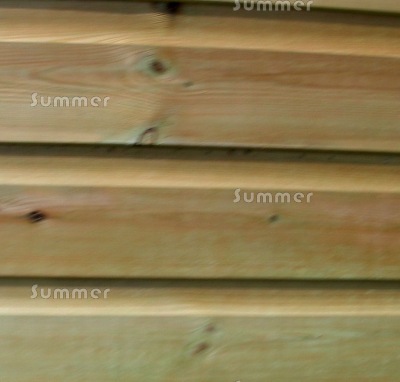
PICTURE: Pressure treated shiplap cladding.
Pressure treatment is a lifetime preservative treatment which will extend the lifespan of your summerhouse. The preservative is forced deep into the timber under pressure in a vacuum and penetrates below the surface. All other treatments apply a coat of stain to the surface of the timber only. With pressure impregnated timber, the chemicals are permanently bonded to the cell structure of the wood at a molecular level. Pressure treated wood is almost colourless except for a slight green tint caused by the copper content in the preservative. No further preservative treatment is ever needed. However, if you want a coloured finish for your summerhouse you can paint over pressure treated or tanalised wood with normal wood preservative in any colour.
View Pressure Treated Summerhouses
Shiplap
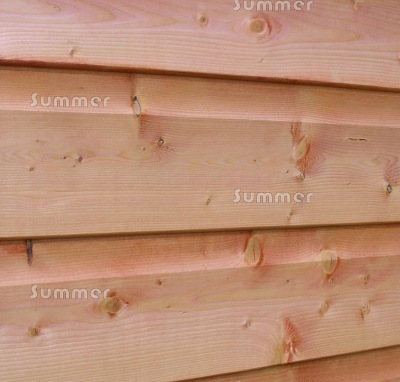
PICTURE: Shiplap cladding.
The traditional and ever popular shiplap profile is used in most of our summerhouses. Shiplap is smooth planed and fully interlocking tongued and grooved boarding. The tongue at the top of each board slots inside the groove at the bottom of the next board up, providing a strong joint between the boards. The shiplap profile is waterproof as suggested by the name, which evokes shipbuilding. The shiplap design ensures that rainwater drains quickly and the timber dries quickly, which ensures a longer life for your summerhouse.
Loglap
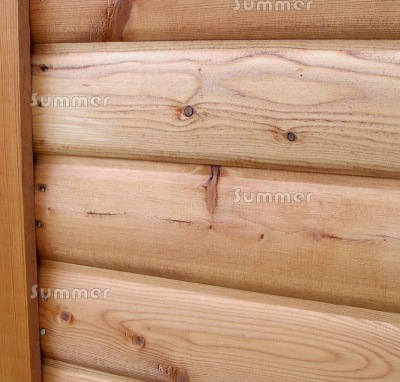
PICTURE: Loglap cladding.
Some of our summerhouses feature cladding with a loglap profile as an option. Loglap is similar to shiplap except the outside is slightly rounded to provide a log effect. It is smooth planed and fully interlocking tongued and grooved boarding which ensures that rainwater drains fast and the timber dries quicker, thus ensuring a longer life for your summerhouse. Loglap is often slightly thicker than shiplap in the middle but the tongues and grooves at each end are almost identical. The performance and strength of shiplap and loglap is similar. The biggest reason to choose loglap is if you like the distinctive appearance.
Painted Finish
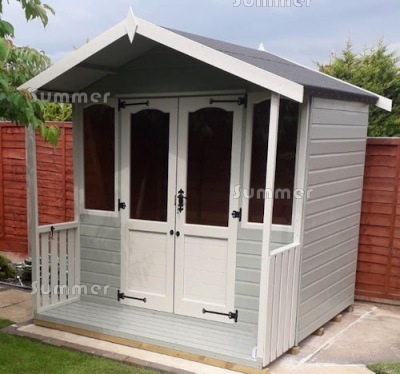
PICTURE: A painted summerhouse with two paint colours.
Some of our summerhouses include a painted finish as standard while others include the paint finish as an option. Some painted summerhouses include only one paint colour while others include a choice of one or two paint colours. With two external colours it is possible to paint the doors, windows and fascias in a different colour to the cladding. Some painted summerhouses also include the option of internal paint treatment. The high quality microporous paint system is available in a choice of colours. Microporous woodstains are impervious to water but not to water vapour, which allows the wood to breathe.
View Painted Summerhouses
Insulation With Internal Lining
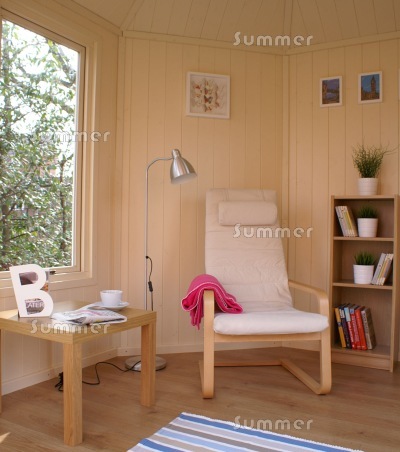
PICTURE: A summerhouse with internally lined walls and ceiling plus a laminated floor.
Some high specification summerhouses and garden offices include floor, wall and roof insulation as standard. With many other superb quality summerhouses the floor, wall and roof insulation are available as an option. Insulated walls and ceilings are supplied with attractive internal lining boards to provide a front room feel. In addition to the attractive internal appearance, an insulated summerhouse also has more practical benefits, being more comfortable in extreme heat or cold. If you want to use your summerhouse as a garden office or a studio throughout the year we recommend insulation and double glazing. Double glazing is especially important if your summerhouse or garden office includes a large area of glazing.
Click here to see Glazing Options
GLAZING OPTIONS
Use our Search Options to choose from a selection of Glazing Options. Many summerhouses include a large glazing area so it is worth taking a little time to consider the most suitable glazing for your personal garden room.
Double Glazing
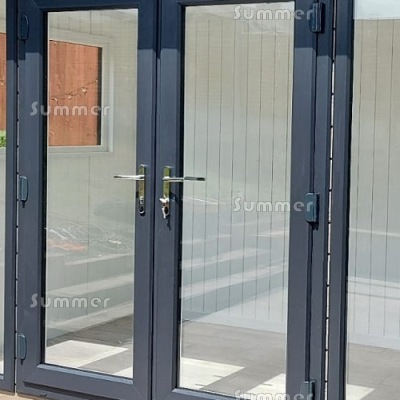
PICTURE: An insulated summerhouse with double glazed PVCu doors and windows.
Double glazed doors and windows are available in PVCu or wood. Double glazing ensures that your summerhouse is warmer and cheaper to heat. We recommend double glazing if you want to use your summerhouse all year round, for example as a garden office. Double glazing also provides additional sound insulation. If you expect to use your summerhouse frequently and for prolonged periods we also recommend floor and roof insulation. Insulation ensures a more comfortable environment on the hottest days in the summer and the coldest days in winter.
View Double Glazed Summerhouses
Georgian Glazing
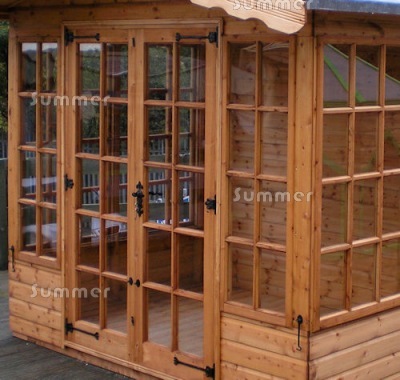
PICTURE: A traditional apex summerhouse with Georgian glazing and individual panes of glass.
Georgian glazing is a traditional design with small squares of glass. It is very practical. Some summerhouses feature Georgian style glazing with individual panes of glass. Other Georgian summerhouses feature criss cross beads fitted over one large pane of glass. The smaller panes of glass are much harder to break and less dangerous when broken. With individual single pane Georgian glazing a considerable force is required to shatter the glass. Toughened safety glass is not normally necessary with such small panes of glass.
Leaded Glazing
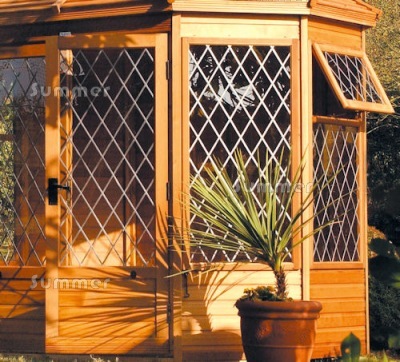
PICTURE: A traditional octagonal summerhouse with diamond leaded glazing.
Traditional style leaded glazing is normally offered with clear untinted glass. Leaded glass can be supplied either square leaded, with a rectangular pattern, or diamond leaded, with a diamond pattern. Traditional leaded glass was intricate with lots of tiny pieces of glass. Modern leaded glass looks similar to the traditional styles but it is applied to a single pane of glass. Leaded glazing adds a traditional style to any summerhouse but if your property features leaded glazing a summerhouse with similar glazing is a neat way to reflect the original style.
Panoramic Low Level Glazing
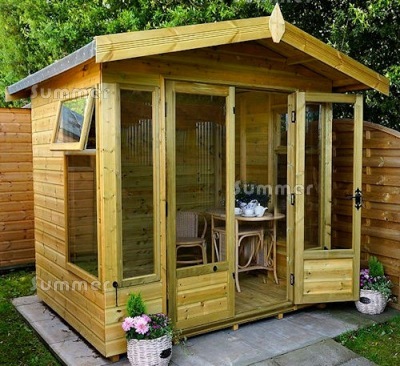
PICTURE: A modern summerhouse with panoramic low level glazing.
Low level glazing provides a panoramic view from inside your garden room so you can appreciate your garden fully and for longer while remaining sheltered. With low level glazing you can enjoy a better view of the garden, especially at sites where the garden slopes away.
Glass or Styrene
We recommend glass with your summerhouse. Toughened glass is best if you can afford it, if not standard glass is better than styrene. Although fragile, glass is more rigid and durable than the styrene glazing supplied with many of the cheapest summerhouses. Styrene glazing is normally less than 2mm thick and prone to blowing out in the wind, especially at an exposed location. Styrene is not as rigid as glass so it flexes in the wind. Over time styrene glazing becomes scratched and cloudy. By contrast glass remains clear and rigid for decades. We recommend toughened glass with your shed if you can afford it, if not standard glass is better than styrene. Even if you only clean the glass occasionally, each time it cleans up like new.
Toughened Glass
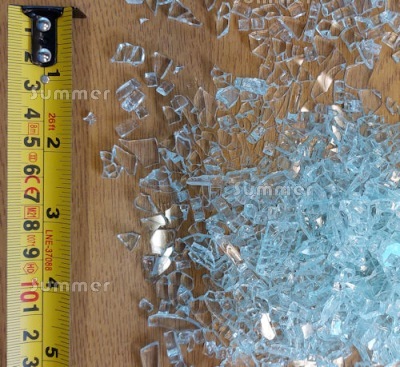
PICTURE: Broken toughened glass.
Toughened safety glass is around six times stronger than normal glass so it is less likely to break. When it does break, toughened glass breaks harmlessly into very small pieces. This makes toughened glass the best option for all the family including children, pets and the elderly. Summerhouses often include a large area of glazing so the cost of toughened glass is higher, but the benefits are amplified.
View Toughened Glass Summerhouses
Click here to see Door Options
DOOR OPTIONS
The doors are an important part of a summerhouse, partly for comfortable access but also for additional ventilation. The doors are also a striking feature of any summerhouse. On a hot day the doors can be wide open, providing important extra ventilation to supplement the opening windows. Later in the evening the doors can be shut to keep the summerhouse warm inside.
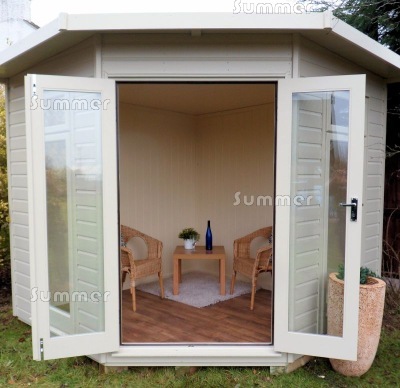
PICTURE: A lined and insulated corner summerhouse with french doors fully open.
The most popular option in a summerhouse is double hinged doors, often described as French doors, which can be fully opened when needed. Large fully glazed doors provide a panoramic view from inside and a contemporary style from outside. French doors also provide a wide range of ventilation options from one door ajar to both doors fully open. French doors provide most of the ventilation in a smaller summerhouse. We also offer sliding patio doors in some of our best summerhouses. Another popular option with a larger summerhouse is folding doors. Folding hinged doors provide similar benefits to french doors but are even wider with more ventilation options. French doors include 2 door leaves but folding doors normally include 3 or 4 door leaves.
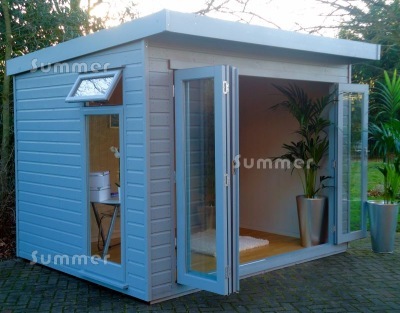
PICTURE: An insulated garden office with 3 pane folding doors fully open.
Click here to see Roof Options
ROOF OPTIONS
Use our Search Options to choose from a selection of Roof Options.
Roofing Felt
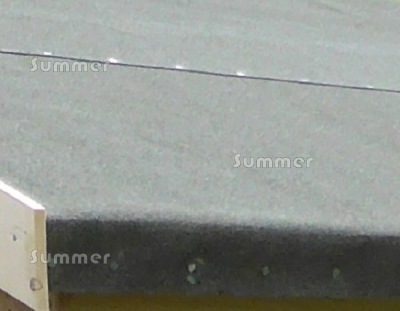
PICTURE: Roofing felt
Many summerhouses include roofing felt as standard. Roofing felt is a practical and affordable option for a summerhouse. Bitumen based with a durable and attractive mineral surface, roofing felt is generally easier to fit than other roof coverings but over time it may require more maintenance, especially at an exposed location. More decorative roof options are available with some of our summerhouses, including the options listed below.
Cedar Shingle Roof
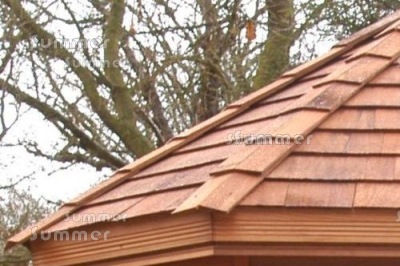
PICTURE: An octagonal summerhouse with a cedar shingle roof.
Attractive and durable, cedar shingles make the ideal roof for high specification summerhouses. These genuine cedar roof shingles are traditionally made from Western Red Cedar and fitted on top of a felted solid pine inner roof. Each individual cedar tile is a known as a shingle. Cedar shingles have long been a popular roofing material for domestic and public buildings in large parts of North America where cedar shingles have a reputation for warmth and longevity. Cedar has an unrivalled reputation for durability and cedar shingles often last for many decades. A cedar shingle roof takes time to fit, especially if the roof is hexagonal, octagonal or hipped, but the results are stunning and most people find it a very satisfying project. The finished roof will also last for a very long time. A cedar shingle roof is easier to fit on a simple apex roof.
Felt Tiles
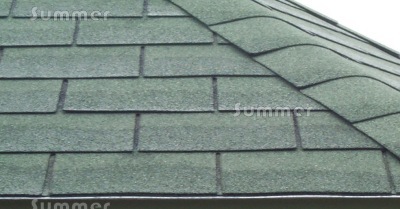
PICTURE: A hexagonal summerhouse with felt tiles.
Mineral coated bitumen felt tiles are an attractive and durable roofing material which is more hardwearing than standard roofing felt. Traditionally used in the UK for garden buildings such as summerhouses, felt tiles are used much more in Scandinavia and North America where they are used widely in general housebuilding. Mineral felt tiles are often described as felt shingles because they resemble traditional cedar shingles. The felt tiles are much thicker and stronger than standard roofing felt. However, felt tiles take longer to fit, especially for a hexagonal, octagonal or hipped roof summerhouse.
Timber Slatted Roof
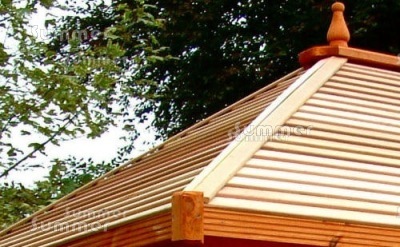
PICTURE: A hipped roof summerhouse with a timber slatted roof.
This attractive and durable timber roof is fitted on top of a solid wooden inner roof with a layer of roofing felt. The planed smooth finish ensures that rainwater drains away faster and the timber boards dry quickly, which ensures a longer life for your summerhouse. A timber slatted roof is often described as a boarded roof. Occasional treatment is recommended to ensure maximum durability, although a slatted roof with cedar or pressure treated boards will last longer than standard boarding even without treatment. A boarded roof is less vulnerable to wind than most other roof coverings.
EPDM Rubber
Some pent roof summerhouses are available with an EPDM roof. A tough EPDM rubber membrane is made in one piece to the size of your roof with no joins. It is easily fitted at normal temperatures with no heat required. EPDM rubber is completely inert, UV stable and not affected by extreme temperatures. It never perishes and it will not rot, split, crack or degrade. EPDM rubber lasts for years with little or no maintenance. It has been widely used in flat roofing for over 40 years from Alaska to the Middle East. It is increasingly popular in the UK where it is widely used for re-roofing flat roof garages and extensions. Even in extreme weather conditions EPDM rubber remains flexible and it will stretch to absorb any movement as a timber roof expands and contracts with the seasons.
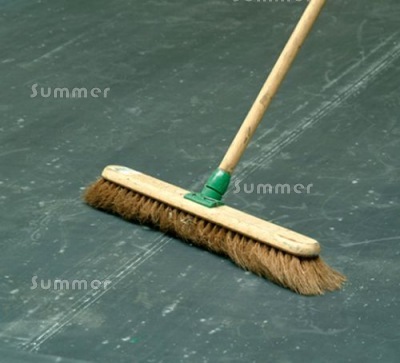
PICTURE: A one-piece EPDM rubber roof.
Under 2.5m High
The option to reduce the height is available with some of our summerhouses. The reduced height helps to ensure that in most cases your summerhouse should not need planning permission. All summerhouses are subject to the same planning laws. Under current planning regulations garden buildings which are within 2 metres of a boundary and over 2.5m high (8'2") normally require planning permission. Some summerhouses with apex or hipped roof designs may be over 2.5m high but pent roof summerhouses are normally less than 2.5m tall. You can often find the height listed within our product descriptions. For more information about planning please see our FAQs.
Click here to see More Options
MORE OPTIONS
The More Options menu allows you to narrow your search even more. Be careful when using narrow and specific searches. It is normally a good idea to search with and without the search option set, just to be sure that you do not miss any suitable summerhouses. Useful search filters such as Best quality and Budget price allow you to focus on a limited selection to suit your requirements. You can also search for specific design features such as Two rooms, Verandah, front or Verandah, side.
Express Delivery
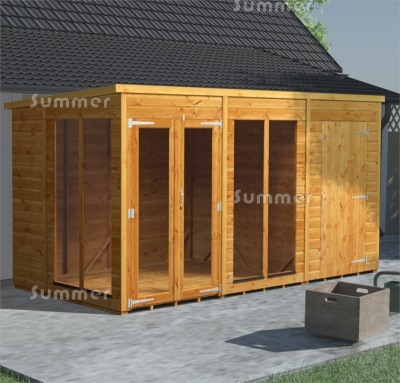
PICTURE: This 2 room summerhouse includes delivery within 2-3 days.
We offer a selection of quality summerhouses which are in stock and delivered within 2-3 days. You can order online and choose delivery on the next available weekday as you order, or you can pick another day that suits you or you can delay the delivery until you are ready and then pick your day. You can request a delivery day weeks in advance or you can wait to choose a delivery day later.
Express delivery is included throughout mainland England, Wales, southern Scotland and central Scotland. Delivery to northern Scotland or offshore addresses may take a few days longer.
You can find accurate delivery information for any of our summerhouses in the online product description under the Delivery heading. The current delivery lead time and other details are listed. Most of our summerhouses are not delivered for at least a few weeks and some of our best summerhouses may be a couple of months or more during our busiest periods. If you are not in a hurry you have the widest choice, but if you need your summerhouse fast we have a wealth of expertise in delivering these heavy and bulky products.
View Summerhouses with Express Delivery
Two Room Summerhouses
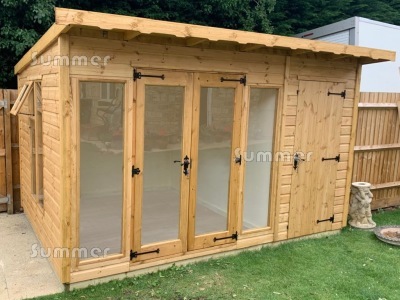
PICTURE: A two room summerhouse.
Two room summerhouses are often used to accommodate a summerhouse and a shed neatly under the same roof. The larger room normally features double hinged glazed doors for use as a summerhouse. The smaller room is normally designed as a storage area with a fully boarded door. Many of our best summerhouses are a single room as standard with internal partitions available as an option. You can add optional partitions and internal doors to suit your own individual room layout.
Front Verandah and Side Verandah
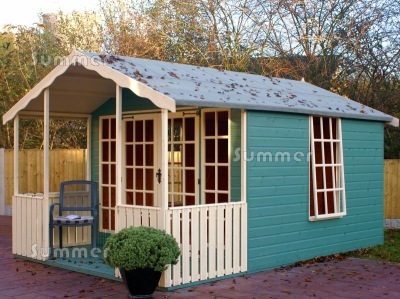
PICTURE: A summerhouse with a front verandah and balustrades.
Another popular design feature with summerhouses is a verandah. We offer a wide range with a choice of either a front verandah or a side verandah. Verandahs can be either open or partially enclosed with a balustrade. A summerhouse is often used as an informal seating area with wide open doors and windows, which is open to the garden. The verandah is an obvious extension of this use, providing a more open covered seating option between the garden. The verandah may be more popular when it is warmer outside but as the evening cools the summerhouse becomes more comfortable. The word verandah can also be spelled as veranda. It is one of many words which were imported from India during the colonial era. Larger summerhouses with a side verandah are popular as sports pavillions, especially with cricket clubs and bowls clubs.
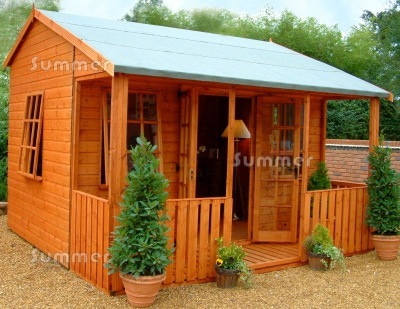
PICTURE: A pavilion style summerhouse with a side verandah and balustrades.
Click here to see Optional Accessories
OPTIONAL ACCESSORIES
We offer a wide range of accessories so that you can customize your summerhouse with everything you need to finish it off and kit it out from one supplier at a competitive price. We often deliver several accessories together which keeps our prices competitive. However, some accessories are delivered separately for a variety of reasons. For example, preservatives are delivered separately in specialist packaging designed to reduce messy spillages. We often offer package deals with a bundle of several accessories at a reduced price. With many of our summerhouses there is a choice of some free offers and some low cost offers. In addition, our package deals are a genuine opportunity to save money with a bundle of accessories at reduced prices to tempt you to buy our summerhouse in preference to a summerhouse from another supplier.
DIY Preservatives
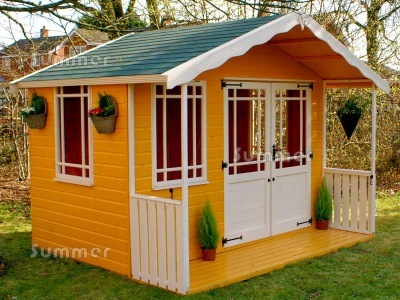
PICTURE: A painted finish with two contrasting colours.
Our quality microporous preservatives are impervious to water but not to water vapour. This allows the wood to breathe. We offer a selection of woodstains and natural wood oils in a wide choice of colours. These preservatives are safe for use with children and pets. Our wood preservatives and wood oils are only available when you purchase one of our summerhouses or if you ever purchased one of our summerhouses in the past. We are always happy to supply our past customers at any time, even years after your purchase.
Solar Lighting
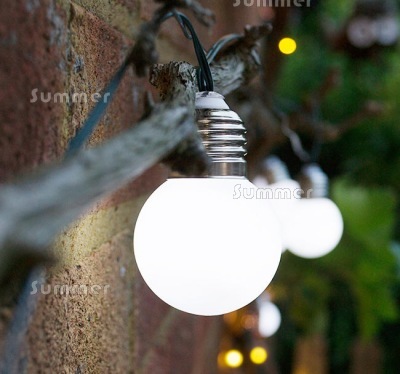
PICTURE: Solar powered string lights with large bulbs.
Our ingenious and affordable solar powered lighting is easy to install with no mains wiring and it costs nothing to run. During the day the externally mounted solar panel converts daylight into electricity and recharges the batteries. The solar panel is weatherproof and suitable for outside use. It is normally positioned on the roof of a summerhouse or high on the walls. For best results the panel should be in direct sunlight for hours every day.
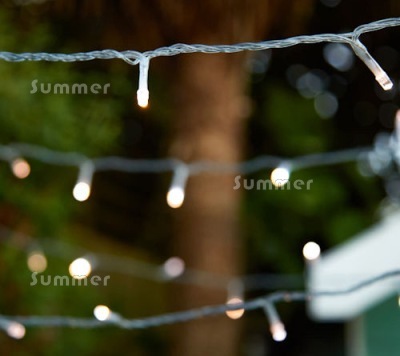
PICTURE: Solar powered string lights with small fairy lights.
Decorative string lights automatically turn on at dusk. The string lights can be set to constant or flashing mode. String lights are especially popular with summerhouses and garden rooms. Often the lights are stretched along the corners and edges of the roof and walls to frame the summerhouse. String lights vary from small fairy lights which are decorative and the larger replica bulb style which provide more useful light when required.
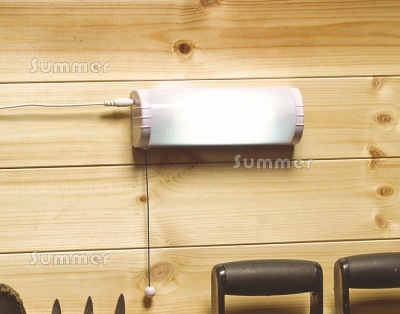
PICTURE: A solar powered inside light.
Internal wall lights solve the problem of seeing inside your summerhouse at night. Using the simple pull cord the light can be turned on and off as required. The solar panel absorbs light all day to provide hours of light whenever required.
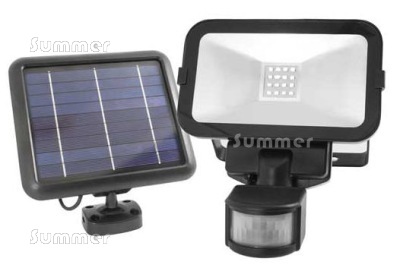
PICTURE: A solar powered security light.
Security lights with passive infra red movement detectors switch on when movement is detected. As you approach the security light it switches on, illuminating the approach to your summerhouse at night whenever required. It may also deter burglars.
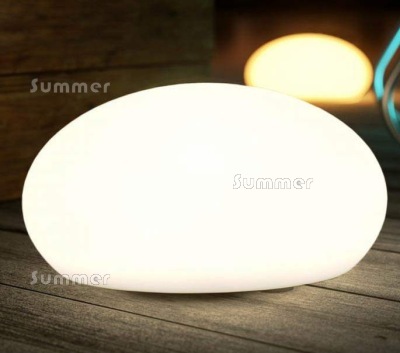
PICTURE: A solar powered table light with programmable colour changes.
We offer a selection of solar powered mood lighting and garden lights. Some of the more sophisticated mood lights change colour periodically and this is programmable to suit your preferences. You can also programme these mood lights to remain constantly the same colour if you prefer.
WPC Composite Decking Kits
Many of our summerhouses include a terrace or a covered verandah, either as an option or included in the price. Now, with our decking kits you can create your own terrace to a size and shape that fits your garden. Our superb quality WPC wood plastic composite decking closely resembles real wood, with the same look and feel. However, it is virtually maintenance free and it will never rot. Our WPC composite decking is a revolutionary material which provides all the benefits of real wood without the maintenance. Unlike real wood this synthetic wood is a weatherproof material with no knots, splinters, machining marks or other imperfections. It will never develop splits or shakes and no sap will ever ooze out of it. Occasional cleaning with soapy water normally restores the original appearance. If any dirt or stains become ingrained after prolonged neglect even the most stubborn marks can be cleaned with a pressure washer.
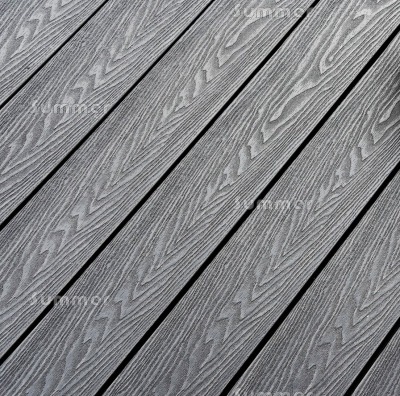
PICTURE: Grey woodgrain WPC composite decking.
Summerhouse Furniture
A summerhouse is primarily used as a relaxing garden room for sitting in. You may prefer informal lounge furniture or more formal dining sets. We offer a huge choice of garden furniture, much of which is ideal for use in a summerhouse. Popular furniture for a summerhouse ranges from a couple of reclining chairs, a love seat or a bistro set to a spacious corner sofa with thick cushions and footstools. Our dining furniture sets are also suitable if you plan to use your summerhouse as an enclosed dining area. The only type of furniture you may want in your summerhouse which we do not currently supply is office furniture for use in a garden office. We are an experienced specialist supplier of garden furniture but office furniture is not our speciality.
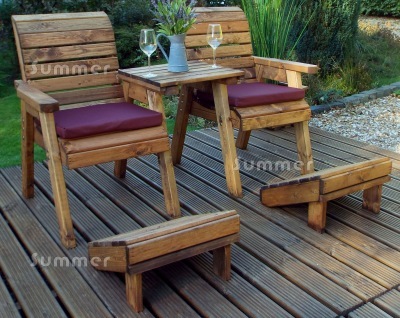
PICTURE: A love seat with cushions and foot rests.
Our lounge sets often include a small coffee table. Our dining sets include larger and taller tables to suit dining. Our wooden furniture ranges from benches, love seats and swing seats to larger lounge and dining sets which accommodate 6 or 8 people in comfort. We offer a choice of wood including pressure treated timber, hardwood and teak. We also offer artificial woven rattan furniture with a wide range of lounge sets, corner sets and dining sets. Our metal furniture is both affordable and lightweight and includes our elegant vintage range and our comfortable textilene sets. Some of our furniture is fully assembled for your convenience and some is designed for DIY self assembly at great value prices.
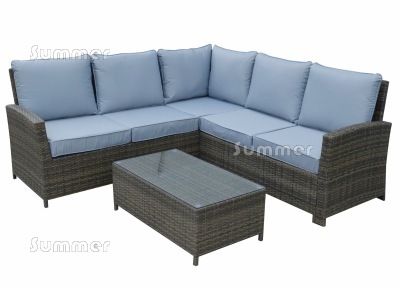
PICTURE: A 6 seater rattan corner sofa with coffee table.
Click here to see Installation Options
We have always been interested in helping our customers at every stage of their garden building project. As a result, since we were established in 1981 we have developed a unique expertise. We offer expert advice and we can answer any query, however technical. We can also actively assist at every stage from making a planning application to advice about ongoing care and maintenance after completion. We can even help you with base preparation. Many of our summerhouses include installation, either free or as a low cost option. Many other summerhouses are designed for DIY assembly. If you prefer to install the summerhouse yourself we provide useful tips for DIY customers. We also provide a comprehensive range of low cost DIY base kits.
INSTALLATION OPTIONS
- We offer several installation options if you want to have your summerhouse professionally fitted.
- Please note that if installation is available with your chosen summerhouse it should be very obvious when you view the product on our website. It is a great selling point, so if you cannot see installation being offered it is probably not available.
- Some of our best value summerhouses are designed for DIY assembly and professional installation may not be available.
- The fitting service does not include base preparation. A flat and level base is required, which can be made using concrete, paving slabs, pressure treated timber or plastic. In many areas we offer a base laying service as an option. We also offer heavy duty plastic base kits as a DIY option in all areas.
DIY Assembly Only
Most of our summerhouses are designed for simple DIY assembly with basic hand tools. DIY assembly is not normally difficult with pre-fabricated panels and cut to size components. Many of our cheapest summerhouses are only available flat-packed for DIY assembly, with no installation option available. Our cheaper summerhouses feature compact packaging to ensure efficient storage and delivery, helping to reduce the price. The panels may be smaller with more panels overall, the doors and windows may not be factory-fitted but supplied loose, the hinges and handles are often supplied loose for you to fit on site and there are normally more fixings. Overall these cheaper summerhouses may take a little longer to assemble, but the price is significantly cheaper. The cheap prices are welcomed by many customers, but there is a price to pay in terms of time. If you are a keen DIY enthusiast these great value DIY summerhouses are an excellent option, providing a cheaper price and better value for money.
Optional Installation After Delivery
We offer an installation service with some of our cheapest summerhouses. The building is delivered first and the installer follows separately, normally a few days later. It is not possible to install the building at the same time as delivery because the delivery team are focused on fast and efficient deliveries. A separate contractor follows on later to install your summerhouse. This type of installation is not cheap, partly because the installer needs to travel to the site and partly because these great value summerhouses are not designed for professional fitters and take a little longer to assemble. We recommend that you look at the overall price including installation and have another look at our range. You may find that other summerhouses you initially disregarded as too expensive may be cheaper overall if they are fitted free or if the fitting charge is much lower.
Optional Same Day Installation
Many of our best summerhouses include same day installation as a low cost option. If you order installation your summerhouse will be delivered by the fitters and installed on the same day by prior appointment with you. These summerhouses are designed to be professionally installed so more care is taken in the factory to speed up installation and minimize problems on site. The result is better quality summerhouses which are easy to fit and longer lasting. Same day installation is convenient for you and cost effective because it saves travelling costs for the installation team. Other summerhouses are fitted by sub-contract fitters who visit separately, often from far away and often a week or two after the delivery. Waiting for the fitter can be frustrating. Sub-contract fitting is also much more expensive because of the travelling costs.
Free Same Day Installation
Some of our best summerhouses include free installation. Because every building is fitted free they are better made than other summerhouses using better quality components. Over time regular feedback from fitters ensures that design weaknesses have been rectified. Everything possible is done to simplify the installation and minimize problems on site. The doors are factory fitted complete with locks and handles. Often the glass and glazing beads are factory fitted. The result is a better quality summerhouse which is fitted quickly with fewer complications. Our free in house installation service is not just convenient, it is also your assurance of a better quality summerhouse.
Underfloor Bearers
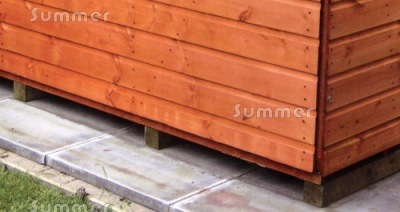
PICTURE: A set of bearers below a timber floor.
Some of our best summerhouses include optional bearers, a traditional base option which is increasingly difficult to find nowadays. Although not essential, if you can afford the extra cost we recommend bearers at most sites even if you have a concrete or paving base, because they will protect your investment in the long run. Bearers are substantial pressure treated beams under the floor, which will prolong the life of your building. The bearers are the only part of the building which is in contact with the ground and they are pressure treated for longer life. The bearers also raise the floor above the ground. This allows air to circulate under the floor to reduce dampness and also reduces saturation of the lower cladding boards. A drawback with bearers is that they increase the step up into your summerhouse.
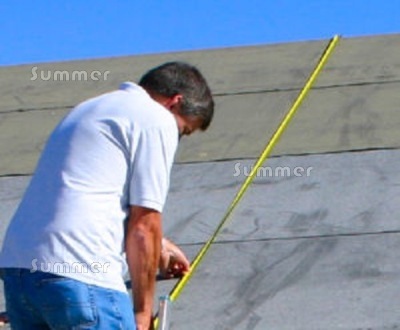
PICTURE: A fitter laying roofing felt on a timber roof.
Click here to see Base Options
In addition to our unique network of installers, we also maintain a national network of baselayers who can build a base for many of our summerhouses. This option is only offered with summerhouses which include free or optional installation. Although our network of baselayers covers many areas we are unable to offer blanket nationwide coverage. This is one of the reasons we developed our unique postcode based website, so that once you have set your delivery postcode you only see services and products available in your area.
BASE OPTIONS
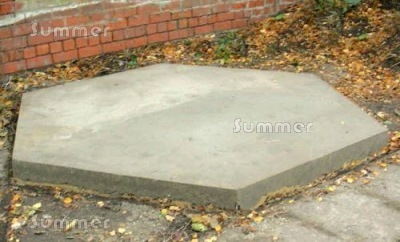
PICTURE: A hexagonal concrete base.
- We can introduce you to independent baselayers in many areas offering to build paving slab bases, concrete bases and pressure treated timber bases.
- Alternatively, we can offer a choice of DIY base options if you want to build the base yourself.
- To see prices for any base options you need to be viewing a specific product.
- To see accurate prices and availability in your local area you need to first enter the first half of your postcode at the top of any page.
Independent Baselayers
Since we were established in 1981 we have connected thousands of customers to our unique network of independent baselayers. Specialist teams have offered to lay bases for our buildings in many areas at low fixed rates in return for regular work. The prices are offered within a specific area and subject to conditions. You deal direct with the baselayer which keeps the prices low and you pay them separately on completion.
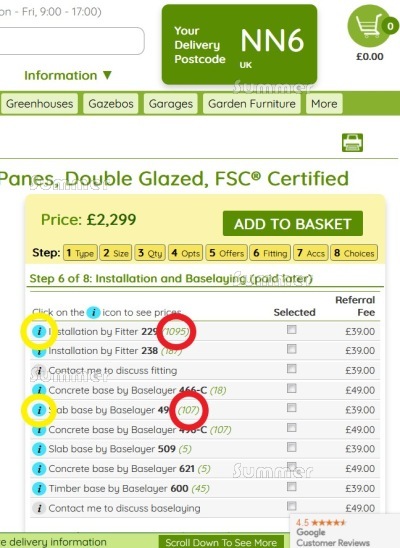
PICTURE: Click on the blue "i" symbols to see fitting and base laying prices (circled in yellow). See how many jobs each fitter or base layer has completed in brackets (circled in red).
We make no commission except for a small upfront referral fee. The baselayers pay us nothing and we pay them nothing. Although we do not manage or supervise the work directly we listen carefully to feedback and any team who provides a poor service is removed from our network. For decades this effective system has provided a low cost option for our customers with high levels of satisfaction.
A base completion date is specified when you order. This is normally four weeks after the order date unless an alternative date is agreed. The building is delivered shortly after this date. The completion date may be longer at busier times or due to holidays.
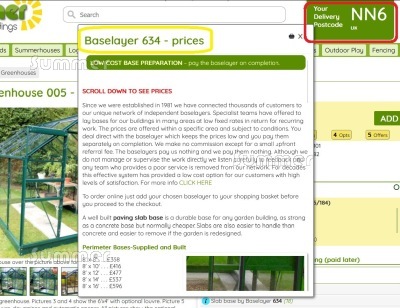
PICTURE: See where to set your delivery postcode (circled in red). See the pop-up window with each fitter or baselayer's prices (circled in yellow).
We regularly monitor the prices charged by our baselayers. In over 80% of cases the actual prices charged and the prices quoted above are exactly the same. However, there are circumstances in which additional charges may be required including, for example if site clearance is required, if the ground is not level or if access is restricted. We recommend the customer to confirm the price payable with the baselayer before work starts. We also recommend the baselayer to advise the customer at the earliest opportunity if the price is likely to exceed the prices quoted above.
Site Clearance and Preparation
A tape measure should be used to mark out the area of the base. The corners can be marked with canes or bricks. To ensure that the area is square the two diagonal measurements should be the same. The edges are easier to cut with a straight edge such as a wooden plank and a spade or turf cutter. All vegetation and roots should be removed otherwise as the organic material decomposes the base may settle unevenly. Large trees should only be removed by professionals. Small trees and shrubs can be removed by untrained people if care is exercised. To remove turf cut horizontally using a spade just below the roots at a depth of around two inches.
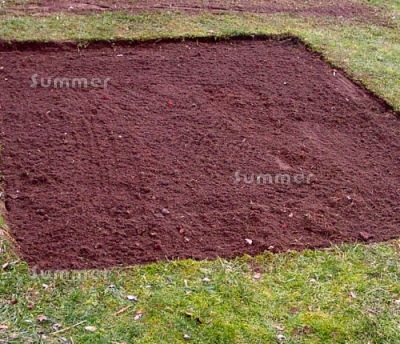
PICTURE: An area of lawn neatly excavated prior to base construction.
Excavation and Levelling
The soil can be levelled using a rake to even out minor peaks and troughs or a spade to dig away higher ground. Any large stones or roots should be removed. Before starting to lay the pavers a spirit level should be used to thoroughly check that the soil is level in all directions. The dimensions should also be checked with a tape measure. Extra time spent at this stage will be rewarded later. The base must be flat and level and large enough before proceeding to the next stage.
If possible allow space around a building to ensure comfortable access for installation and maintenance. If the base is sited near a wall or fence remember to allow for the roof overhang. Any overhanging trees or branches should be cut back.
Professional baselayers often charge extra for significant excavation, for the removal of existing obstructions such as existing buildings, garden walls, trees or compost heaps and for rubbish disposal if the spoil cannot be disposed of on site.
Paving Slab Bases
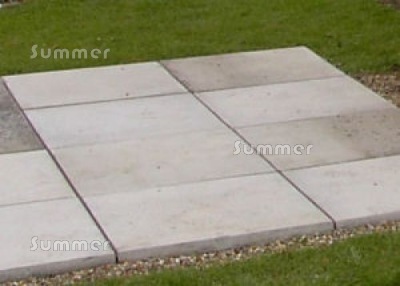
PICTURE: A paving slab base with smooth vibrated grey concrete slabs.
A well built paving slab base is a durable base for any garden building, as strong as a concrete base but normally cheaper. Slabs are also easier to handle than concrete and easier to remove if the garden is redesigned. Professional baselayers should include supplying and laying paving slabs on sand, mortar or concrete.
Concrete Bases
A concrete base is the most permanent and durable base for a garden building but a paving slab base is cheaper and more popular. A concrete base requires shuttering boards with a sturdy frame. Wet concrete is poured in and tamped smooth with a straight edge. A concrete base is often the best option for a building with no floor, such as a garage or a commercial workshop, or for a building which contains heavy machinery or equipment, such as a pump room or a hot tub enclosure. The concrete is normally finished a few inches above the ground. Inexpensive steel reinforcing can be placed within the concrete for extra strength at sites with poor ground conditions, for example where trees and shrubs have been removed.
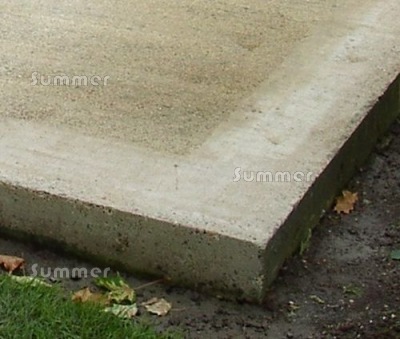
PICTURE: Ripple finish concrete with smooth floated chamferred edges.
We recommend 100mm thick concrete with a thickened toe beam tapering to 300mm thick at the edges. An interval of up to seven days is advisable between the base and installation. However, if required in warmer weather it may be possible for installation to proceed with care after a shorter interval.
Pressure Treated Timber Platform Bases
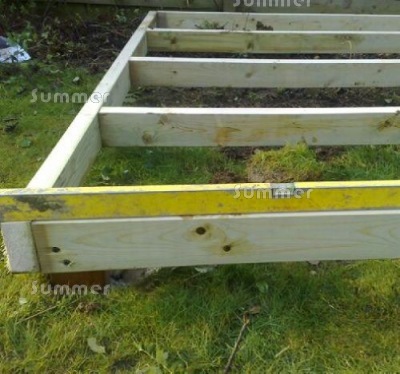
PICTURE: A timber platform base.
A pressure treated timber platform base is suitable for any building with a timber floor, especially at a sloping site or a site with made up ground or a recently remoived tree. It is also an option for building without a floor but the platform needs boarding over, for example with decking. The substantial timber platform is an ecologically sound alternative to more traditional bases such as slabs or concrete. It can be easily built over sloping or unstable ground without expensive excavation or levelling. The base is made from pressure treated timber bearers and posts. Pressure treatment is a lifetime preservative treatment. The platform should be finished a few inches above the ground allowing for better airflow than other base options. The support posts are concreted into the ground to ensure the base remains flat and level. If you choose quick setting concrete to hold the posts in place you can start installing your new building if you are careful within about half an hour.
DIY BASE OPTIONS
Our durable eco-grid and eco-paving base kits are a practical and affordable alternative to slabs or concrete. Lightweight and easy to install within a few minutes, these 100% recycled polypropylene pavers simply click together with no fixings needed. The interlocking design helps to spread weight and ensures greater rigidity. Weed membranes are not needed below a timber floor. The self draining design prolongs the life of a timber floor. Unlike paving or concrete our plastic bases are fully relocatable. The base is normally at least 2" or 50mm larger than your building. Where space permits the base is normally laid full size but if required in a tight location our plastic pavers can be cut. Fast delivery within 3-5 days ensures that you can start work quickly.
Eco-Grid Bases
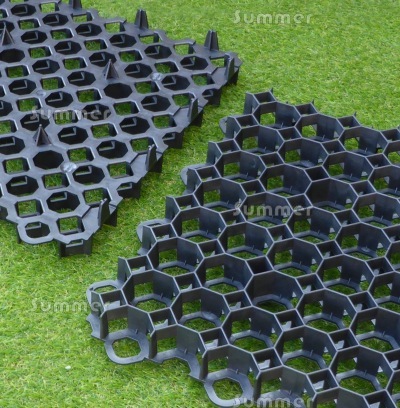
PICTURE: Eco-grids viewed from above (to the right) and below (to the left).
Eco-grids are recommended if the sub-base is soil, sand or pea shingle but not on hard surfaces such as concrete, because the underside is not flat. Integral pegs on the underside help to level the base grids more easily in soil or sand or shingle. Our eco-grid plastic bases can support up to 200 tonnes per square metre. We offer exactly the same eco-grids as driveways and carparks. Gravel or shingle infill is not required below a timber floor. Whatever you store in your building, our eco-grids will support the weight easily. Each eco-grid is 472mm x 472mm and 40mm thick with an immensely strong 60x60mm hexagonal cell structure. Extensive preparation is not normally required - just level the soil and lay the pavers directly on soil or on a thin layer of sand or pea shingle. Any exposed edges around the base can be left unfilled or filled with gravel or shingle.
Eco-Paving Bases
Eco-paving is recommended if the sub-base is a hard surface such as concrete or paving slabs, because the pavers feature a flat and level underside. Our eco-paving is less brittle than concrete paving slabs. The pavers have a strong lattice structure underneath and the surface looks and feels similar to pressed concrete slabs, with a slightly textured finish. Each eco-paver is 385mm x 385mm and 40mm thick. The pavers are quickly and easily easily laid over an existing hard surface.
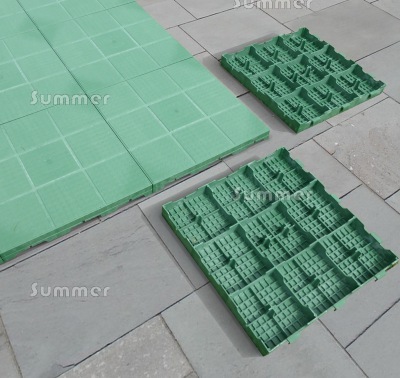
PICTURE: An eco-paving base, viewed from above, with two extra tiles upside down to show the underside.
Click here to see Sustainability Info
We love wood so we specify timber which originates from sustainable forests. We research our supply chains, regularly assessing the risks and testing different species in accredited labs in the UK for verification purposes. We are also fully paid up and longstanding members of FSC® (Forest Stewardship Council) and PEFC (Programme for the Endorsement of Forest Certification). We are regularly audited to confirm our compliance with FSC and PEFC accounting requirements, to check our supply chains in detail and to verify our claims regarding individual products.
Recent developments in the timber industry include extraordinary shortages and unprecedented price increases following the Covid-19 pandemic, followed by the Russian invasion of Ukraine in 2022. Timber from Russia and Belarus is now banned from UK and European markets and FSC certification has been suspended. As UK and European reliance on cheap Russian timber has ended, supplies of more expensive timber from Scandinavia has increased.
Sustainability of our summerhouses
Except for cedar, all wood used in our summerhouses is from Northern Europe, including boards, framing and pressure treated timber. Until recently much of this timber came from Russia and Belarus but now it comes from Scandinavia and the Baltic. Our cedar summerhouses and cedar roof shingles feature cedar from Canada and the USA. The forests of Northern Europe and North America are among the most well managed and sustainable forests in the world.
Chains of custody
It is not easy to prove a chain of custody all the way from the forest to the wooden summerhouse in your garden. It only needs one broken link to break the chain. The only way to be sure is to follow an unbroken trail of sales invoices and purchase invoices all along the chain. We are members of FSC and PEFC because they specialise in certifying chains of custody and they have global reach. Any summerhouse we describe as FSC certified or PEFC certified has verified chain of custody certification from the forest to the finished summerhouse.
Valid FSC claims
- If you want to buy an FSC or PEFC certified timber product you can only buy it from an FSC or PEFC member.
- Many of our wooden products do not include FSC or PEFC certification, but some do.
- We only make legitimate FSC and PEFC claims when we have full chain of custody certification.
- If you cannot see a prominent FSC or PEFC claim against one of our products, then it is not certified.
- An FSC certified product must be described as FSC 100% or FSC Mix Credit or FSC Mix 70% and this claim must be accompanied by a valid licence number and/or certificate code from a genuine FSC member. Any other claim is invalid.
- A PEFC certified product must be described as 100% PEFC Certified or 70% PEFC Certified and this claim must be accompanied by a valid licence number and/or certificate code from a genuine PEFC member. Any other claim is invalid.
- The FSC Mix claim can be a different percentage, but in our experience we have only ever known 70% to apply to our products.
- There are 3 other FSC claims and 1 other PEFC claim which are never relevant to our wooden products (FSC Recycled XX%, FSC Recycled Credit, FSC Controlled Wood and PEFC Recycled).
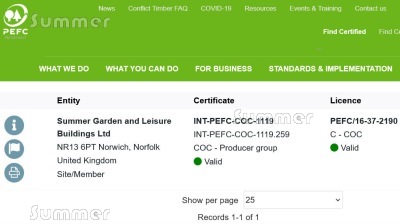
PICTURE: Our entry in the PEFC members database.
Invalid FSC or PEFC claims
- Retailers often make vague claims that products are "FSC certified" or "all timber is from a PEFC certified supplier" or "we only use FSC approved timber". However, these claims are dishonest because FSC and PEFC certify products and not suppliers. If the claim is invalid the timber is not certified.
- Any FSC or PEFC claim is invalid unless it is accompanied by a certificate code and/or a licence number from a genuine FSC or PEFC member.
- Many FSC and PEFC members regularly sell non-certified products - indeed, we are a good example of this. Buying from a member is no guarantee that the wood is certified.
- Many FSC and PEFC suppliers have two production lines, one for certified and one for uncertified wood. This practice is perfectly acceptable, as long as the certified wood is correctly accounted for.
- To remain members we must pay for regular audits to confirm that our FSC and PEFC claims are valid. Auditors compare our purchase invoices with our sales invoices to confirm that the quantities balance. All other members are also audited regularly to verify the supply chain from the forest to the consumer.
Verify our FSC and PEFC membership
- To verify our FSC membership visit the FSC Member Search and search for Summer Garden (full name "Summer Garden and Leisure Buildings Ltd"). Our FSC licence number is FSC-C109654 and our FSC chain of custody certificate code is INT-COC-003944.
- To verify our PEFC membership visit the PEFC Find Certified and search for Summer Garden (full name "Summer Garden and Leisure Buildings Ltd"). Our PEFC certificate number is INT-PEFC-COC-1119. Our PEFC licence number is PEFC/16-37-2190.
- If you suspect that an FSC claim on a website may be invalid, use the FSC Member Search to check if the supplier is a valid FSC member. If the claim is invalid you can report it to FSC.
- If you suspect that a PEFC claim on a website may be invalid, use PEFC Find Certified to check if the supplier is a valid PEFC member. If the claim is invalid, you can report it to PEFC at info@pefc.co.uk.
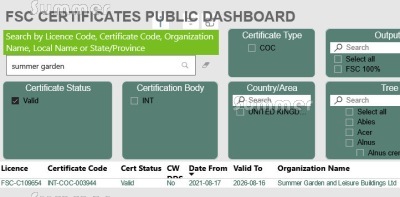
PICTURE: Our entry in the FSC members database.
About the FSC and PEFC: The FSC and the PEFC are non profit international organizations which promote responsible forest management throughout the world. Around 430 million acres of forest worldwide in over 90 countries has been certified. FSC or PEFC chain of custody certification verifies that certified material has been identified and separated from non-certified and non-controlled material at every step throughout the supply chain.
See more information About FSC and PEFC
Visit the FSC website
Visit the PEFC website
Thank you for shopping with Summer Garden Buildings - a leading UK specialist since 1981.

